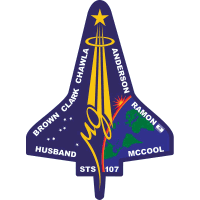Columbia

Commander:
Rick Douglas Husband, Colonel, USAF
Pilot:
William C. McCool, Commander, USN
Payload Commander:
Michael P. Anderson, Lieutenant Colonel, USAF
Mission Specialist:
Kalpana Chawla, PhD
David M. Brown, MD, Captain, USN
Laurel Blair Salton Clark, MD, Captain, USN
Payload Specialist:
Ilan Ramon, Colonel, Israel Air Force



































5 comments
I was always crossing my fingers every time the Space Shuttle flew, because they were basically launching proof of concept prototypes into space as if they were production vehicles. There were major design flaws and limitations that were well known by everybody involved with the program, flaws and limitations that would have been worked out if the program had ever been fully funded and produced the fleet of production-quality space planes that had been originally envisioned, but that part of the program never happened due to lack of funding and instead they flew the hand-built pre-production prototypes as if they were actual production-quality vehicles. They weren’t. They couldn’t be, regardless of all the attempts to work around the flaws in the design. It was always a case of when, not if, one would blow up or disintegrate upon re-entry.
As I said, everybody involved in the program knew this, including the seven people aboard. They chose to continue flying because they saw it as important to maintain human access to space until the people down below got off their asses and realized that putting all your eggs into one basket is insane. They were the pioneers doing the space science needed for humanity to progress further into space, and they knew that pioneers are the ones who end up with arrows in their backs. For those who boarded the Shuttle, every one entered not expecting to come back. Most did, thankfully. But the courage of these people cannot be underestimated.
Among the reasons that the Soviets gave up on their copy of the shuttle, the Buran [means Blizzard, but worse] is they couldn’t get a successful mission out of it. It had no value even for agitprop, and they ran out of cash before they could get close to a manned test.
You look at how many have died during the development of the Osprey, and the shuttle had a reasonable safety record for a test vehicle, but not an operational aircraft. They knew about the O-ring shrinkage, and were aware of the danger of tile loss, but people want to go to space, even if it means giving $100+ to Richard Branson, Paul Allen, or Elon Musk.
The aircraft I flew in were “one offs” that started life as something else and were modified to suit our needs. Then they were launched from gawd-awful places like Shemya & Eielson. They did jobs that needed to be done and it cost more people than NASA accidents. You climb aboard because some things are worth the risks.
Buran’s unmanned test was successful, in that it reached outer space and came back without crashing, but it was still well away from being able to actually haul humans into space in a safe and efficient manner. Thankfully the political and economic turmoil in the Soviet Union at the time prevented a repetition of the Tu-144 disaster.
The Osprey and the Shuttle share one characteristic, which is that they are the first of an entirely new kind of vehicle. But the Osprey’s first prototype flew in 1989 and the eventual production design only arrived in 1999 and had been significantly redesigned compared to the early prototypes. The Shuttle never had that ten years of development between prototype and production vehicle, and never entered mass production as the Osprey did. Furthermore, the Osprey is a military aircraft, which has different safety parameters from a civilian aircraft. If the Shuttle had been submitted to the FAA as a jet airliner, it would have been rejected as unsafe, but for a prototype military aircraft it was, as you point out, safer than expected for a prototype military aircraft. But that’s not what it was sold to the public as being. NASA is a civilian organization, not a military organization, and their man-rated craft are supposed to be built to civilian standards of safety, not military standards. The Shuttle never, ever, met that standard.
The aircraft you flew in at least had the advantage of being the end result of at least 30 years of R&D in jet aircraft design and 70+ years of R&D in aircraft design and development, and were based on proven reliable airframes. Most of their issues came from their mission parameters (such as flying out of Shemya) rather than because of lack of development on the underlying airframes. They were dangerous, but for a different reason. This isn’t to say that the people in your aircraft weren’t courageous, because that is of course nonsense. This is more about how civilians kept boarding a prototype space plane time after time, with full expectation they would never make it home, and nobody outside NASA seemed to realize it.
I missed this one! (You & your Dog Sledding Bryan!) 😉🤭😏
All good points & from my time with GD, TI Aerospace, Raytheon and other such US Corp’s, I am certain you are correct Badtux. And I agree Bryan.
All the Shuttle crews were very brave souls. They knew the danger & risks, including the Civilians. And went anyway. The true Pioneering spirit. I often hope their spirit’s (for want of any other name) is still traveling the Stars. I know their atoms & energy are.
Hey, I missed them last year with the flu.
Every country has people willing to take the risk, all that is needed are politicians willing to spend the money.